Leadership Sample Speech
Ladies and gentlemen,
Thank you all for gathering here today. It is an honor and privilege to stand before you as we discuss the importance of leadership and its impact on our lives, our communities, and the world at large.
Leadership is not just a position; it is a responsibility, a commitment to serving others and inspiring positive change. Throughout history, great leaders have emerged, guiding societies through challenges, fostering growth, and leaving a lasting legacy. Today, I want to share some thoughts on what it means to be a leader and how we can all become better leaders in our own spheres of influence.
1. Vision and Purpose:
At the heart of every successful leader lies a compelling vision and a clear purpose. As leaders, we must envision a better future, one that inspires and motivates others to follow. A strong sense of purpose gives us direction, helping us navigate through obstacles and make tough decisions. Let us strive to be visionary leaders, constantly seeking innovative solutions and possibilities, while keeping our purpose firmly rooted in making a positive difference.
2. Empowerment and Collaboration:
True leadership is not about controlling others but empowering them to reach their full potential. We must recognize the strengths and unique talents of those around us and provide them with the resources and support they need to succeed. Collaboration is key – no one person has all the answers. By fostering a culture of teamwork and inclusivity, we can achieve far more together than we could ever do alone.
3. Integrity and Ethics:
Leadership is built on trust, and trust is earned through integrity and ethical behavior. We must be honest, transparent, and accountable for our actions. A leader's character is the foundation on which everything else rests. Let us lead by example, upholding the values that promote fairness, respect, and empathy towards others.
4. Adaptability and Resilience:
In a constantly changing world, leaders must be adaptable and resilient. Challenges and setbacks are inevitable, but it is how we respond to them that defines us as leaders. Embracing change and learning from failures are essential for growth and progress. Remember, it is not the absence of difficulties that makes a great leader, but their ability to rise above them.
5. Communication and Empathy:
Communication is a two-way street – as leaders, we must listen as much as we speak. Effective communication fosters understanding, builds connections, and ensures that everyone's voice is heard. Empathy is equally vital – understanding the feelings and perspectives of others helps us make decisions that consider the well-being of all those affected.
6. Continuous Learning and Mentorship:
Leadership is a journey of continuous learning. We must stay curious and open to new ideas, seeking knowledge and insights to expand our horizons. Additionally, as we grow in our leadership, let us not forget to mentor and support others on their paths. By nurturing the next generation of leaders, we ensure a brighter future for our communities and the world.
In conclusion, leadership is not about titles or personal gain; it is about making a positive impact on the lives of others. As we move forward, let us embrace these principles of leadership: vision and purpose, empowerment and collaboration, integrity and ethics, adaptability and resilience, communication and empathy, and continuous learning and mentorship. Together, we can create a world where great leadership thrives, and the potential of every individual is unleashed for the greater good.
Thank you.
Inspirational Leadership Speech Sample
Good morning everyone,
It is an honor to stand before you today. Leadership is not about titles or positions; it is about influence, responsibility, and the ability to inspire others. A true leader leads by example, motivates the team, and cultivates an environment where every voice is heard.
We must remember that challenges are opportunities to grow. By facing obstacles with courage, embracing change with flexibility, and committing to shared goals, we create a legacy of positive impact. Let us work together to empower each other, foster innovation, and achieve excellence in all that we do.
Thank you.
Formal Leadership Speech for Organizational Meeting
Dear colleagues,
I am grateful for the opportunity to address you today. Leadership in our organization is a shared commitment to integrity, accountability, and collaboration. It is through our combined efforts and shared vision that we achieve meaningful progress.
As we move forward, let us embrace strategic thinking, continuous learning, and mutual respect. By doing so, we ensure our decisions create sustainable value for both our team and the communities we serve.
Thank you for your dedication and support.
Heartfelt Leadership Speech for Team Motivation
Hello team,
I want to take a moment to express my gratitude for your hard work and dedication. Leadership is not about directing others but about supporting, guiding, and lifting each member of our team. Your unique talents and contributions make our collective success possible.
Together, we will overcome challenges, celebrate victories, and learn from setbacks. I encourage each of you to believe in your abilities, take initiative, and embrace collaboration as we work towards our shared vision.
Thank you for your commitment.
Casual Leadership Speech for Youth Program
Hey everyone,
It’s great to be here today. Leadership isn’t about being the boss; it’s about helping each other grow, make decisions, and take responsibility. You don’t need a title to be a leader; you just need courage, kindness, and determination.
Let’s encourage each other, learn from our mistakes, and celebrate our successes together. Each of you has the power to inspire change, and together we can make a real difference.
Keep pushing forward and supporting one another.
Creative Leadership Speech for Conference
Ladies and gentlemen,
Leadership is like crafting a story: each decision, each interaction, and each vision we share shapes the narrative of our team. True leaders are storytellers who inspire others to see possibilities, take action, and contribute their own unique chapters.
Innovation thrives when we empower each other to think differently, take risks, and explore new horizons. Let us lead with imagination, passion, and purpose, creating an environment where creativity fuels progress.
Thank you.
Serious Leadership Speech on Crisis Management
Team,
In times of crisis, leadership is defined not by comfort but by action. We must remain calm, make informed decisions, and communicate effectively. Each of us plays a vital role in steering the organization through challenges while maintaining trust and integrity.
By focusing on solutions, supporting one another, and staying committed to our mission, we can overcome adversity and emerge stronger. Let us face these challenges with resilience and a shared sense of purpose.
Funny Leadership Speech for Icebreaker Event
Hello everyone,
They say leadership is all about taking charge—but sometimes it’s also about knowing when to laugh at yourself. If you can’t find humor in mistakes, you’ll miss the joy in growth. A great leader inspires, motivates, and occasionally tells a bad joke to lighten the mood.
So let’s embrace challenges with a smile, celebrate small wins, and remember that even leaders need a little laughter to lead effectively.
Thank you and let’s have a great session!
Preliminary Leadership Speech for Workshop
Greetings participants,
As we begin this leadership workshop, I want to emphasize that leadership is a journey, not a destination. Each exercise, discussion, and activity we engage in is an opportunity to develop skills, gain insights, and enhance self-awareness.
Our goal is to understand the principles of effective leadership and apply them to real-world scenarios. Engage actively, ask questions, and share your experiences so we can learn from one another.
Together, we will grow as leaders.
Simple Leadership Speech for Community Event
Hello friends,
Leadership is about serving others and making positive changes in our community. It is about listening, caring, and guiding others toward common goals. Even small actions can inspire and create meaningful impact.
Let’s work together, support one another, and lead by example. Every one of us can be a leader in our own way.
Thank you.
What / Why: Understanding Leadership Speeches
A leadership speech is a prepared address delivered to inspire, motivate, or inform an audience about leadership principles or actions.
- Purpose includes:
- Motivating teams or communities
- Demonstrating leadership qualities
- Sharing vision, goals, or strategies
- Encouraging collaboration and innovation
Who Should Deliver a Leadership Speech
- Organizational leaders, managers, and executives
- Team captains or project leads
- Motivational speakers in leadership events
- Educators or mentors leading workshops or youth programs
Whom the Speech Should Address
- Employees or team members
- Students or participants in leadership workshops
- Community members in volunteer or civic programs
- Conference or seminar audiences interested in leadership
When to Deliver a Leadership Speech
- At organizational meetings or annual gatherings
- During motivational or team-building workshops
- At conferences or community events
- When introducing initiatives, projects, or changes
- During crisis management or milestone achievements
How to Prepare a Leadership Speech
- Identify the purpose and key message
- Understand the audience demographics and expectations
- Structure the speech: opening, main content, conclusion
- Use examples, stories, and practical illustrations
- Practice delivery for clarity, tone, and timing
- Adapt tone (formal, casual, humorous, heartfelt) depending on the context
Elements and Structure of a Leadership Speech
- Opening: greeting and statement of purpose
- Introduction: define leadership principles or context
- Main Body: examples, stories, strategies, motivational content
- Closing: call-to-action, inspiring final thoughts, appreciation
- Optional: humor, anecdotes, quotes, or references
Formatting and Delivery Guidelines
- Length: typically 3–10 minutes for standard speeches
- Tone: adapt to context—formal, informal, humorous, or inspirational
- Wording: clear, concise, and audience-appropriate
- Style: narrative, persuasive, or educational
- Mode: live presentation, video recording, or virtual delivery
- Etiquette: maintain eye contact, confident posture, and engagement
Requirements and Prerequisites Before Giving the Speech
- Knowledge of audience needs and expectations
- Understanding of leadership principles being presented
- Prepared speech outline or full text
- Familiarity with any technical setup for presentations
- Rehearsal to ensure confident delivery
Pros and Cons of Delivering a Leadership Speech
Pros:
- Inspires and motivates the audience
- Demonstrates leadership qualities and credibility
- Builds influence and trust
- Encourages engagement and collaboration
Cons:
- Poor delivery may reduce credibility
- Misalignment with audience expectations can cause disengagement
- Time-consuming preparation
Tricks and Tips for Effective Leadership Speeches
- Start with a strong opening to grab attention
- Incorporate stories or real-life examples
- Use rhetorical questions to engage the audience
- Practice voice modulation, pauses, and emphasis
- Adapt content on-the-fly based on audience reactions
- Include actionable takeaways for listeners
Common Mistakes to Avoid
- Overloading with information or jargon
- Reading verbatim without engagement
- Ignoring audience reactions or feedback
- Failing to conclude with a clear, motivating message
- Neglecting rehearsal and timing
FAQ About Leadership Speeches
Q: How long should a leadership speech be?
A: Typically between 3–10 minutes, depending on context.
Q: Can humor be used in leadership speeches?
A: Yes, when appropriate to the audience and context.
Q: Should I use a script or speak extemporaneously?
A: A prepared outline is recommended, with flexibility for natural delivery.
Q: How do I engage a diverse audience?
A: Use inclusive examples, clear language, and interactive elements.
Compare and Contrast with Other Communication Types
- Versus Motivational Speeches: Leadership speeches may include more structured guidance and strategic vision.
- Versus Keynote Addresses: Leadership speeches can be shorter and more practical-focused.
- Versus Informal Talks: Leadership speeches require preparation, structure, and clear objectives.
- Versus Written Communication: Speeches rely on delivery, tone, and engagement, unlike written memos or letters.


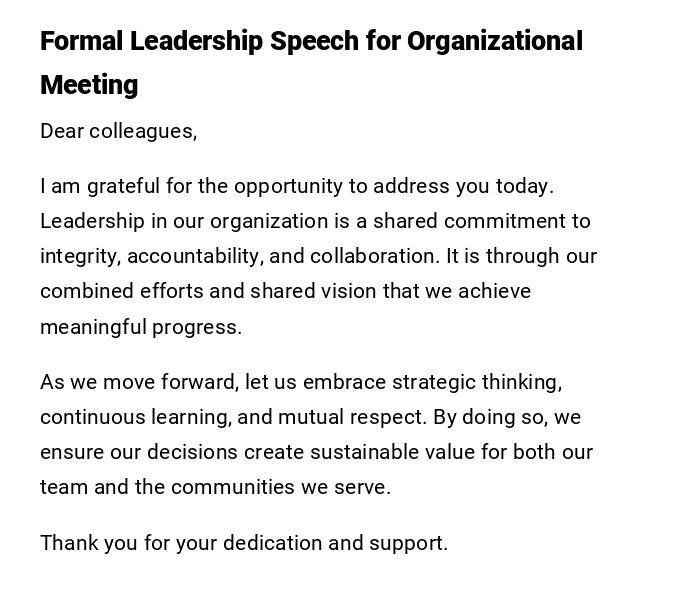
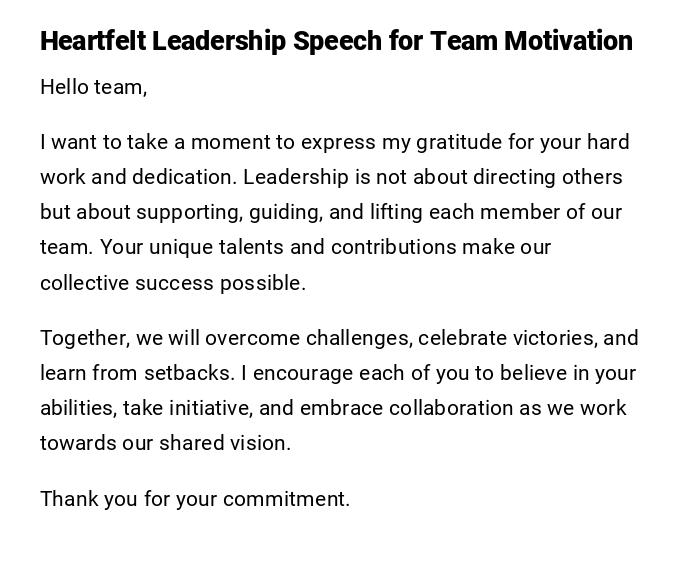
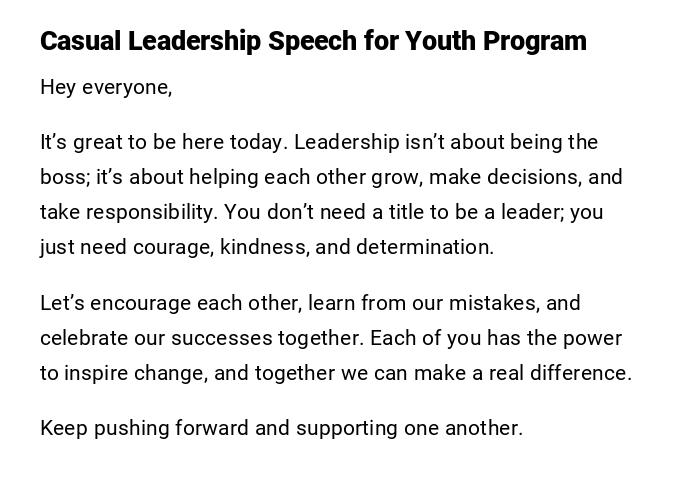



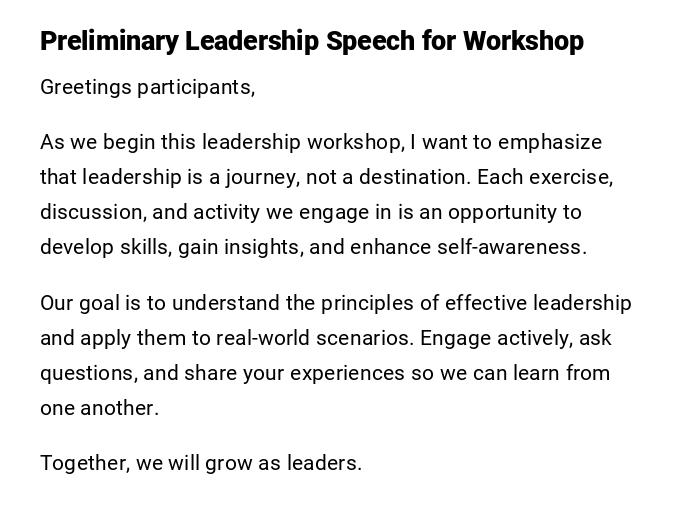
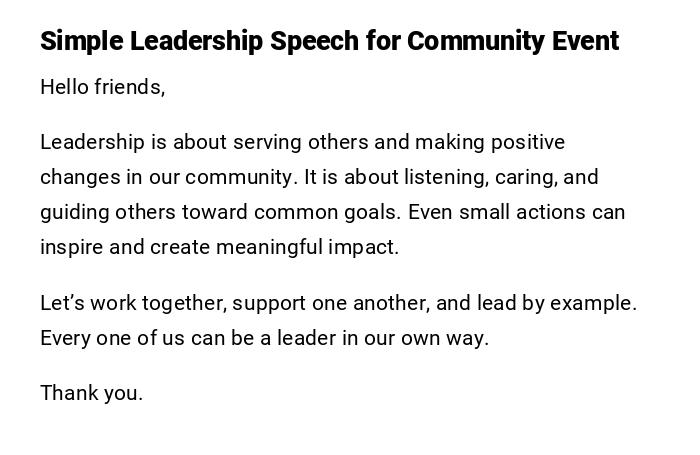

 Download Word Doc
Download Word Doc
 Download PDF
Download PDF